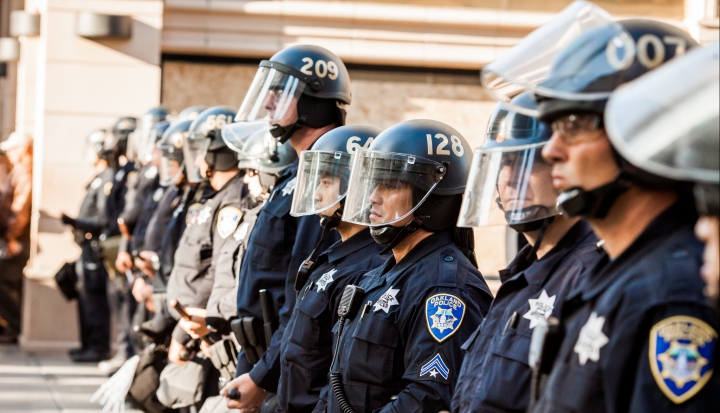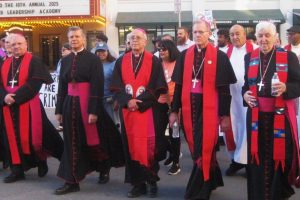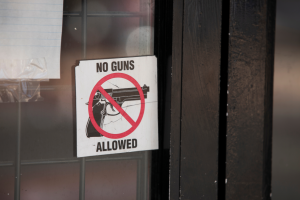Gerald Schlabach first started thinking about peace and violence in the mid-1980s. He and his wife worked for the Mennonite Central Committee in Nicaragua during a time of ongoing civil revolution. A member of the Mennonite church at the time, he was tasked with figuring out how the historically pacifist church should respond to the violence.
“This was a situation where a lot of Christians had said, ‘Our backs are against the wall. We need to resist the tyranny of the Somoza dictatorship (known for their brutality and human rights violations) through violent revolution,’ ” he explains. “And here I am, 27 years old and tasked with speaking up for nonviolence.”
The experience convinced Schlabach that nonviolence is always a worthwhile goal, even if violence seems neverending. There are always people willing to respond with violence but never enough peacemakers.
When asked if war is ever justified, Schlabach says, “I hate that question. If you start asking if there’s ever any exceptional cases where violence is justified, then the exception starts to become the rule. We have to do less work on justifying the violence and more work on making sure we have the skills to make active nonviolence our first, second, and 15th resort.”
In 2004 Schlabach joined the Catholic Church and became, as he describes it, a “Mennonite Catholic.” Part of bridging these two identities for an ethicist meant promoting dialogue between the faiths’ visions of peace and justice. The Roman Catholic tradition holds the idea of a “just war”—the belief that under some circumstances violence is justified. On the other hand, Mennonites are among a group of “historic peace churches” that believe violence is immoral, no matter the situation. Their ideas may seem opposed, but Schlabach hopes they will find some common ground in their shared practices.
What are the origins of just war theory?
There’s a strong case to be made that the Christians in the first centuries were pacifists—people with a strong opposition to bloodshed of any kind and who were outside of the power structure. But that all changed in the fourth century under Constantine, and Christians have been debating the issue ever since.
One way to think about just war theory is as a kind of pastoral counseling. Christians were now in the room where the political decisions were being made, so they had to decide how to react. And just war theory was the result. The charitable interpretation is that Christians now had to determine how to give counsel to political leaders.
These were people who had some level of commitment to their faith, but they weren’t ideal Christians and, as government leaders, had a different set of moral demands placed upon them. People who are very skeptical of the just war theory would say that the church went to bed with the state and sold out on Jesus.
People started asking questions: Is it ever OK to use violence? Is it ever OK to kill? If so, under what circumstances? But when you start asking those questions, it becomes almost a zero-sum game. Any time you say, “Well, maybe under these exceptional circumstances . . .” you’re already justifying war rather than nurturing the social conditions that cause peace.
Can Christian pacifists and proponents of just war theory agree on anything?
Since the Protestant Reformation, a few historic peace churches have said we have to go back to the Bible: Jesus’ teachings about loving your enemy and his way of overcoming evil through the power of suffering is our model. They argue that the cross is the ultimate power in the world. Other Christians interpret things differently: Jesus’ Sermon on the Mount is then set up as “This might work for a few really dedicated, heroic people, but for most of us these are really hard.”
That means there probably isn’t much common ground if you focus on principles. But if you look instead at practices, it turns out there’s a lot of common ground. The question is then not “What exceptional circumstances might allow for the use of violence?” Instead it’s “How does peace break out, and what can we learn from that?” This is the question that ethicists and political scientists started asking at the end of the Cold War, and this question brought together both just war thinkers and thinkers from historic peace churches and Christian pacifists.
It was here that dialogue could happen. On the pacifist side, they asked how it was possible to promote peace without merely being nonviolent. And on the just war side, they started seeing how if you’re really going to take just war seriously—which says that war and violence may be justifiable under certain exceptional circumstances as a last resort—you have to pay a whole lot more attention to what the first, second, and 15th resorts are.
Why are war and peace issues so polarizing?
I believe that militarism is more of a civilian problem than that of soldiers. There’s this whole culture of violence where we turn to militaristic solutions or use it to forge community.
I think this happens when, at best, people confuse their faith identity with their national identity. At worst, national identity trumps faith identity, and people see themselves as Americans first and as Catholics, Baptists, or whatever second.
If that’s the case, we’re not going to get very far with this whole rethinking of just war theory. I’m working on a book right now provisionally titled A Pilgrim People Becoming a Catholic Peace Church. We need to recover the very long thread in the Christian tradition of a pilgrim people. Before globalization, we didn’t have to recognize the global nature of the church, but now we are forced to confront it.
In a sense, the church is itself a people in diaspora or a transnational nation. We are the people of God spread around the world. If we think about the church in this way, we have to pay attention to global solidarity. Even proponents of just war have to decide the question based on the global church, not just on Washington politicians or because Americans are being told to rally around the flag. What are our brothers and sisters in Iraq or Syria saying? Let’s make them the axis of our discernment.
It’s convenient for civilians to say, “Well, we can turn conflicts around the world over to someone else.” Nonviolence is tougher. And it relies on civilians working together. There may be 100 things we have to do together to work for a civil society, restorative justice, and international conflict resolution.
We can start this work in our own communities and parishes, and then a few people who get really good at it may be able to go to conflict zones around the world and partner with local people to help them find solutions that work in their own situations. Active nonviolence starts whenever we begin those hard conversations across the pew, across the dinner table, or across the political aisle. It’s all those things that build up relationships and social capital, which then in turn allows us to find creative solutions to violence in unexpected places.
Does active nonviolence work?
Political scientists Erica Chenoweth and Maria Stephan have a book called Why Civil Resistance Works (Columbia University Press). Through the lens of political science, they look at as many wars and conflicts in the last hundred years as they can. And, using statistical analysis, they find that nonviolent social movements have been successful about twice as often as violent conflicts.
Famous examples of successful nonviolent movements include the Indian independence movement led by Mahatma Gandhi, the Polish Solidarity movement against communism, and South Africa’s Anti-Apartheid Movement. And there are less well-known stories as well. In 2014 Muslim extremists boarded a bus in Kenya and demanded that Christians and Muslims separate. But the Muslim passengers, mostly women, refused. They put hijabs on the heads of the Christian women, and told the militants that they could either shoot everyone or leave. In the end, their act of bravery worked; the militants left without hurting anyone.
To our shame as Christians, it took Mahatma Gandhi—a Hindu—to look at the Sermon on the Mount from a different perspective. There’s real political power encoded in these few verses. Turning the other cheek isn’t just being wimpy; it’s exposing injustice in a way that creates social power.
Gandhi’s understanding of the Sermon on the Mount proves that there’s a way to be a realist, to be actively non-violent, and yet also politically active and relevant. People hear pacifism as passive-ism, but the Latin roots of the word really mean peacemaking, doing, or acting.
Is there such a thing as a just war?
My Christian pacifist roots make me not want to stake my position on this. Historic peace churches know from experience that as soon as a war seems to be just, you lose a lot of your people. I saw this working in Nicaragua in the 1980s: American peace activists would come and look at the Sandinista Revolution and the work it was doing to help the Nicaraguan people and say, “I’m not sure any more.” But if you’re a serious Christian pacifist, you don’t believe in killing even for a just cause. So in that sense, the question of whether a just war exists is moot.
Even within Catholicism there have been growing worries about just war theory. Cardinal Joseph Ratzinger, before becoming pope, said in an interview that we have to take another look at the just war doctrine. And then in 2007, as Pope Benedict XVI, he said again that nonviolence is at the heart of the Christian revolution.
The late Baptist theologian Glen Stassen’s work on peacemaking in the Bible has helped me think about this issue. In the Sermon on the Mount, there’s this long middle section where Jesus says things like, “You have heard that it was said to those of ancient times, ‘You shall not murder’ . . . But I say to you that if you are angry with a brother or sister, you will be liable to judgment” (Matthew 5:21–22). We tend to think of those as having two parts: Jesus says a historic teaching (don’t murder), then offers commentary on it (don’t even get angry).
But Stassen points out that even Jesus gets angry. What we think is the heart of the teaching is really just a prelude. If you continue reading, there’s a third part of the teaching—the transformative part in which Jesus actually gives imperatives about what you should be doing. Jesus goes on to say that if you are angry with your brother or sister at the time, you leave an offering, go first and be reconciled, and then come back (5:23–24). If you only listen to the first two parts of the scripture, you get caught in a vicious cycle: you’re going to get back what you give. And while an eye for an eye is certainly better than nothing—it’s better than saying, “Kill one of my relatives, I’ll kill seven of yours”—it’s not good enough.
This has implications for how just war proponents and Christian pacifists understand each other. And it has possibilities for recognizing each other as fellow Christians, no matter what we believe about war and peace.
When I talk about this with my students I ask, “Do just wars really end war? Don’t they just create the seeds of resentment among the losers that will eventually give birth to another war?” This is starting to gain more traction among just war theorists. The modern era’s vicious cycle is just getting more vicious. Even if you say that theoretically there may be exceptional cases where violence is called for—genocides or things like that, for example—how do you respond to these without escalation? Just war is never going to end war.
The focus then needs to be on transformative initiatives. How do you break out of the cycles of violence, retribution, and vengeance? One of the dynamics of active nonviolence is that when you humanize your enemy, and when you force them to see you as a human being in return, it changes the dynamics. It starts to open up possibilities for peace accords, trauma healing, restorative justice, etc.
You’ve edited a book about policing as an alternative to just war theory. How do you think policing can change the conversation?
After 9/11, I started to notice calls for police action rather than war against the perpetrators. “Treat this as a crime, certainly,” people were saying, “but make sure to use good crime-fighting procedures. Don’t go to war.”
Without claiming that policing could be a grand compromise—that if Christians can agree on policing, we’d solve everything—I realized that Catholics and Mennonites (the two traditions to which I belong) were converging over this one issue. Even if we have different reasons for resisting more wars, this is a place of overlap. And I think we could continue this convergence if each tradition comes clean on policing.
The difference between policing and warfare is that policing is embedded in the community it’s claiming to protect. It’s easier, therefore, to keep tethered to the rule of law. Good police are really trained to minimize violence, which is exactly what the just war tradition says, in theory, you should do. When you send soldiers abroad to war on the other hand, they’re out of their own territory and don’t necessarily have a sensitivity to the local population, and this opens up the entire situation to being abused. Soldiers aren’t held accountable in the same way.
Does just policing take into account police-inflicted violence?
When considering any kind of policing, whether domestic or international, the first thing to do is to resist continued militarization. Community policing has to be much more the model, where police themselves are paying attention not just to the symptoms of conflict but also to the conditions that tempt people to violent solutions. Instead of a “we versus them” mentality, they need to have a “we are them” approach.
The question then is about how to transfer this to the international sphere. A part of the answer is by paying a lot more attention to the conditions that lead to violence and social conflict. It’s not just what we do after 9/11. It’s how we build up communities through measures like diplomacy and international aid. This is parallel to what community policing does but on a different scale.
If we’re doing all that, then we’re also building up stronger relationships with other populations and legitimate governments. Insofar as there are criminals to apprehend, we can rely on more support, better intelligence gathering, and the ability to more selectively apprehend criminals if we’re not alienating the communities they come from.
This seems pretty idealistic. What would such a police force look like in reality?
In my vision of policing your average police officer is more like the old bobbies in England. They’re not necessarily armed, and the use of violence is reserved to what we now call “SWAT teams.” Now, these teams are overused; they’re part of the militarization of police. But something like that can exist if it’s really held in reserve for emergencies.
Internationally, I’d be glad to get to the point where the use of expeditionary military forces was more like the use of SWAT teams in our own communities. Admittedly, we’re still learning to do that even domestically, to prosecute terrorism as a crime, to avoid racial profiling, things like that.
Few people propose bombing entire neighborhoods in the United States, even with well-targeted drones. Technically, in just war theory you can justify collateral damage. But we don’t do it. So why do we think that this is going to work in societies we know even less well? How do we think this is going to solve the problem?
What I want to say to just war theorists is, “If you want to convince me and other skeptics that just war is acceptable, then prove that it’s always a last resort. Invest in forming our own people in the active nonviolence that truly makes war a last resort.”
What role does discernment play?
There are so many church documents that challenge popular understandings of just war. The challenge is formation. Too long have conscientious objectors had the burden of proof. They were the exception. But we don’t have a shortage of peacebuilding strategies; we have a shortage of peacebuilders. If just war theory is doing its job, then alternative service would actually be the norm.
Catholic Relief Services is engaged in peacebuilding efforts around the world. What if this kind of work was how we saw our primary identity as Christians? Otherwise, our very notion of what it means to serve the common good is going to be way too nationalistic and way too vulnerable to being pulled in violent directions. This is my theological vision. This is what I believe the church is supposed to be. It should be our primary identity.
If I could dream a little bit more, I’d say that I’d love to see a Catholic version of the Mormon expectation that young people will give two or three years to some kind of mission or service work. If that was the norm, there would be a set of institutions to guide young people through the process. We’d have a structure to test young adults who say, “I want to serve the common good by joining the military or becoming a police officer.”
It’s a work of formation. It’s a work of conversion. At a certain point, you do your best to trust it’s a work of the Holy Spirit, too.
This article also appears in the February 2017 issue of U.S. Catholic (Vol. 82, No. 2, pages 28–32).
Image: Flickr cc via Thomas Hawk














Add comment